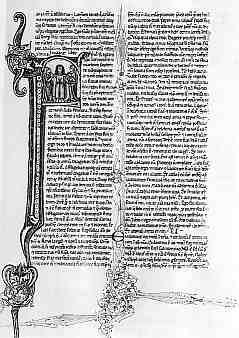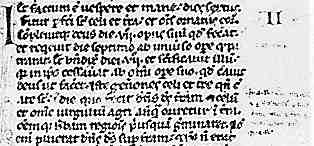


If you are looking at this page without frames, there is more information about medieval writing to be found by going to the home page (framed) or the site map (no frames).
| Little Tiny Bibles (2) | |||
 |
This example shows the tiny, and heavily abbreviated, script. These Bibles often contained a calendar of church feasts before the Bible text itself. The saints chosen for commemoration in these calendars can indicate the geographical and religious origin of the volume. The calendar for this volume lists St Francis but not St Dominic, so one might assume it is for Franciscan use. Funny though, you might think they would have supported each other a bit. Perhaps it represents a sort of medieval ecclesiastical sibling rivalry. | ||
| Sample of text from a Bible of the early 13th century (British Library, Arundel MS 303, f.56b). (From The New Palaeographical Society 1911) | |||
 |
This page from a small Bible shows a historiated initial and some marginal decoration between the two columns of text. The calendar indicates it is for French Dominican use. After the calendar there is a table of themes for sermons, verse summaries for all chapters of the four gospels, and tables of the epistles and gospels. In other words, the materials additional to the core text are all aids to preaching and teaching. | ||
| Page from a small Bible of the mid 13th century (British Library, add. ms. 31830, f.97, end of preface and beginning of First Book of Samuel). (From The New Palaeographical Society 1911) | |||
| The Dominicans produced some corrections and revisions of the Vulgate text of their own. These did not replace the original text, but were added as alternative readings in glosses. The example below shows one of these texts with a minute (and unreadable) gloss in the margin. | |||
 |
Segment from a later 13th century Bible (British Library, add. ms. 37487, f.3b). (From The New Palaeographical Society 1911) | ||
| These new Bibles were not just added to the repertoire of manuscript Bibles being produced, they largely replaced the commercial production of larger format works for some time. They brought the Bible text out of the monasteries and into the world of lay people, but not in a form that they could consult and interpret for themselves. The Bible was only available to those not literate in Latin through the interpretation of the authentic text by those considered qualified to do it. | |||
|
|
|||
|
|
|||
|
If you are looking at this page without frames, there is more information about medieval writing to be found by going to the home page (framed) or the site map (no frames). |
|||